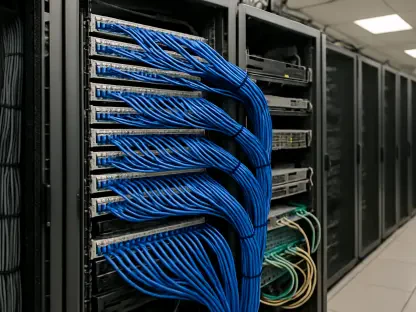Hewlett Packard Enterprise (HPE) has recently made significant updates to its HPE Aruba Networking Central solution, introducing new deployment options and security features aimed at bolstering network security for enterprises facing increasingly sophisticated threats and stringent regulatory demands. By offering versatile deployment models and advanced AI-powered capabilities, HPE’s enhancements provide a robust framework for securing enterprise networks in today’s dynamic cyber environment.
Deployment Flexibility and Security
The flexibility of deployment options is a cornerstone of HPE Aruba Networking Central’s latest advancements. Enterprises can choose from four distinct deployment models: cloud-delivered Software as a Service (SaaS), Virtual Private Cloud (VPC), on-premises, and Network as a Service (NaaS). This variety ensures that organizations can select the deployment method that best fits their unique security requirements, data sovereignty concerns, and compliance with regional regulatory frameworks such as GDPR and FINRA.
One of the standout features is the introduction of HPE Aruba Networking Central On-Premises for Government. This deployment option is particularly tailored to meet stringent government security standards, incorporating FIPS 140-2 certified server hardware. Such rigorous compliance ensures that sensitive data and critical operations are protected against potential breaches. By extending these robust security measures to government entities, HPE demonstrates its commitment to addressing the specific needs of high-security environments.
AI-Powered Optimization and Security Measures
The integration of Automated Network Artificial Intelligence for IT Operations (AIOps) into HPE Aruba Networking Central plays a pivotal role in enhancing enterprise security. AIOps continuously monitors network operations, proactively optimizing performance and detecting potential issues before they escalate into significant security threats. This continuous surveillance is crucial in identifying and mitigating vulnerabilities that malicious actors could exploit.
AI-powered assistants within the AIOps framework act as intelligent network architects. These digital assistants gather real-time data, perform comprehensive diagnostics, and recommend actionable measures to improve network security. By identifying configuration errors and closing security gaps, AIOps helps maintain the integrity and reliability of enterprise networks. This intelligent optimization ensures that networks are not only efficient but also resilient against emerging cyber threats.
Comprehensive Network Observability
HPE Aruba Networking Central has also made significant strides in enhancing network observability and data lake telemetry. This advancement provides enterprises with deeper visibility into their network environments, enabling them to pinpoint vulnerabilities and respond swiftly to security threats. Enhanced observability is crucial in maintaining secure and reliable network operations, especially in complex and heterogeneous IT environments.
A key component of this improved observability is a one-year subscription powered by OpsRamp, which facilitates monitoring of third-party devices. This capability extends the reach of HPE Aruba Networking Central, allowing it to oversee a wider array of network components and critical IT applications. For instance, the enhanced monitoring capabilities significantly improve support for Microsoft Teams’ voice and video calls, ensuring that communication remains secure and dependable.
Enhanced Telemetry and Predictive Analytics
HPE’s extensive device telemetry data lake now manages over 5.2 million devices and serves more than 2 billion network devices. This vast repository of anonymized telemetry data underpins the advanced AI capabilities and predictive analytics of HPE Aruba Networking Central. By securely integrating with multiple generative AI Large Language Models, the platform can offer precise predictions and recommendations that bolster network security.
Predictive analytics enabled by this expansive data lake allow enterprises to identify potential threats and optimize network configurations proactively. The insights derived from telemetry data empower organizations to address vulnerabilities before they can be exploited, thereby enhancing the overall security posture of their networks. This proactive approach is essential in a landscape where cyber threats are constantly evolving.
Third-Party Observability and Integration
Another notable development is the introduction of the HPE Aruba Networking Central OpsRamp Extension license for third-party observability. This license enables monitoring of devices from vendors such as Cisco, Arista, and Juniper Networks, further enriching the platform’s observability capabilities and strengthening its security measures. By providing a more comprehensive view of the network environment, this feature enhances the ability to detect and respond to potential threats.
Moreover, native integration for Microsoft Teams’ end-to-end telemetry ensures that the quality of voice and video calls is monitored and optimized in real-time. This integration supports secure and efficient communication within enterprise environments, addressing potential vulnerabilities associated with these critical applications. By maintaining high-quality and secure communication channels, enterprises can mitigate risks and ensure smooth operations.
Strategic Geographic Expansion
HPE has also increased its global points of presence (PoP) to ensure secure and efficient data routing for the cloud-delivered HPE Aruba Networking Central. Dedicated instances in various regions, including the U.S., Canada, the E.U., the Middle East, Africa, Asia Pacific, and China, support organizations that prioritize data sovereignty and local presence. This geographic expansion is crucial for enterprises that must adhere to regional data protection regulations while maintaining high-security standards across their network operations.
By expanding its global footprint, HPE enables enterprises to meet their data sovereignty requirements without compromising on performance or security. This strategic expansion underscores HPE’s commitment to providing secure and versatile network management solutions that cater to the diverse needs of its global customer base.
Integration APIs and Source of Truth
The extensive integration APIs offered by HPE Aruba Networking Central facilitate the seamless sharing of network observability context with other enterprise IT tools. This integration enhances the functionality of affiliated IT services, offering substantial AI-powered telemetry insights that strengthen overall network security. These insights act as a major “source of truth” for network observability, providing enterprises with unparalleled visibility into their network environments.
By serving as a primary source of truth, HPE Aruba Networking Central ensures that organizations can make informed decisions based on accurate and comprehensive data. This holistic approach to network management allows enterprises to maintain robust security measures while optimizing network performance and reliability.
Continuous Evolution and Customer Trust
Hewlett Packard Enterprise (HPE) has recently introduced significant updates to its HPE Aruba Networking Central solution. These enhancements feature new deployment options and advanced security features, aimed at strengthening enterprise network security amidst increasingly complex threats and strict regulatory requirements. By integrating versatile deployment models along with AI-driven capabilities, HPE is providing a comprehensive framework to protect enterprise networks in today’s rapidly evolving cyber landscape. These updates are designed to meet the growing demand for robust security measures, enabling enterprises to efficiently handle threats while adhering to regulatory standards. In addition to improved security, the advanced AI features enhance network management, contributing to smoother operations and heightened overall performance. HPE’s innovations are set to empower businesses to stay ahead in the continually changing world of cyber threats, leveraging both technology and intelligent design to foster a secure and efficient network infrastructure.









